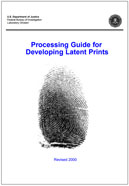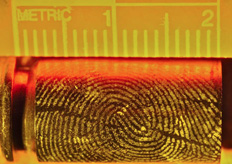|
View in browser: http://www.crime-scene-investigator.net/newsletter/0523.html
|
||
|
MAY 2023 | ||
Welcome to the May 2023 Crime Scene Investigator Newsletter
| ||
|
This Month's Featured Resource on the Crime Scene Investigator Network Website
|
||

The beginning of this manual is a list of processes and procedures for different surface types. Also included are processing sequences that specifically involve prints that are left in blood. Following these lists are details for each process that is currently implemented in the Latent Print Unit (LPU) of the Federal Bureau of Investigation (FBI) Laboratory. |
||
|
Featured Video Presentation
|
||
|
Learn the basic technique for processing latent fingerprints by dusting with black powder. |
||
|
New CSI and Forensic Job Announcements
|
||
|
The most comprehensive listing of Crime Scene Investigation and Forensic To be notified of job openings as they are posted, follow us on Twitter: Job Posting Alerts |
||
|
Crime Scene/Property Evidence Specialist
Menifee Police Department, Menifee, California, USA Final Filing Date: May 24, 2023 Performs a variety of technical and specialized duties related to crime scene investigation and property and evidence management; identifies, diagrams, photographs, collects, transports and preserves evidence from crime scenes; receives, processes, stores, safeguards, delivers, releases, and disposes of police property, evidence and supplies; <View complete job listing> |
||
|
Crime Scene Technician
Fort Myers Police Department, Fort Myers, Florida, USA Final Filing Date: May 24, 2023 Responsible for processing crime scenes including, but not limited to collection, and preservation of physical evidence, photographing the crime scene and evidence. Responsible for the processing of crime scenes and evidence for latent fingerprints for use of identification. <View complete job listing> |
||
|
Crime Scene Technician
Wichita Falls Police Department, Wichita Falls, Texas, USA Final Filing Date: May 31, 2023 Responding to crime scenes and documenting scenes through videography, photography, diagram and measurements, collecting and packaging evidence, collecting and comparing fingerprints, maintaining digital images, examining items for trace evidence, and photographing and fingerprinting victims, suspects, and new employees. <View complete job listing> |
||
|
Forensic Analyst (Crime Scene)
Denton Police Department, Denton, Texas, USA Final Filing Date: June 5, 2023 Locates, documents, collects, and preserves physical and digital evidence at scenes and in the laboratory. Reconstructs crime scenes by using available physical evidence to determine actions and activities of suspect(s) and victim(s) through accepted forensic disciplines and scientific practices. <View complete job listing> |
||
|
|
||
|
Latent Print Specialist
Escondido Police Department, Escondido, California, USA Final Filing Date: May 29, 2023 Performs latent print examination and identification; identifies, photographs, collects and preserves latent print evidence from crime scenes; provides technical guidance and leadership in latent print analysis and performs difficult and complex examination of latent prints in connection with the investigation of crimes; conduct latent print development; gives expert testimony in the courts in all phases of latent print examination; <View complete job listing> |
||
|
Forensic Photographer I - Digital Media Specialist
Institute of Forensic Sciences, Houston, Texas, USA Final Filing Date: May 23, 2023 Produces postmortem examination photographs using professional digital cameras to document pertinent findings as determined by the forensic pathologists, provides photographic coverage of trainings and events as needed <View complete job listing> |
||
|
Forensic Scientist I-VI Bio/DNA
Texas Department of Public Safety, Austin, Texas, USA Final Filing Date: May 25, 2023 Examines stains to determine the presence of blood and other human body tissues and secretions, perform procedures used to extract DNA from these tissues, and conduct DNA testing to compare evidence with samples of known origin. Evaluates, interprets, and documents the DNA tests, and reviews the work of other DNA analysts. <View complete job listing> |
||
|
Forensic Technician
Jackson County Medical Examiner's Office, Kansas City, Missouri, USA Final Filing Date: Open until filled Responsible for providing forensic autopsy assistance to the Medical Examiners and custodial maintenance services to the equipment and facilities in the morgue and related areas. May at times be asked to perform investigator duties including responding to scenes and conducting death investigations. <View complete job listing> |
||
|
Search for more job listings in Crime Scene Investigations and Forensics To be notified of job openings as they are posted, follow us on Twitter: Job Posting Alerts |
||
|
Other Resources on the Crime Scene Investigator Network Website
|
||
|
Crime Scene Investigator mdash; Blog
Crime Scene Investigator Forum How to Become a Crime Scene Investigator Crime Scene Response Evidence Collection Crime Scene and Evidence Photography Crime Scene Investigation Articles Video Presentations College and University Programs Employment Resources and Links |
||
|
Not Subscribed to this Newsletter?
|
||
|
If you are not subscribed to this newsletter, you may subscribe with this link: SUBSCRIBE via email |
||
|
To Unsubscribe
|
||
|
To unsubscribe from future e-mail newsletters, please click here: UNSUBSCRIBE Copyright ©2018 Crime Scene Resources, Inc. Crime Scene Investigator Network |

 Cartridge casings found at crime scenes may contain fingerprint evidence to introduce or help convict a suspect; however, there are few articles on the subject of the best method to develop fingerprints on cartridge casings. The purpose of this research was to compare the best development methods for unfired casings found in previous research along with other commonly used development methods. After the most effected method was determined, that method was then applied to fired brass cartridge casings. Five different methods and five hundred unfired .40 caliber brass cartridge casings with one fingerprint on each were used. The two techniques that yielded the best results were cyanoacrylate fuming followed by gun blue followed by BY40 and cyanoacrylate fuming followed by BY40 followed by acidified hydrogen peroxide. The technique that produced the highest average of fingerprints of comparison value was cyanoacrylate fuming followed by gun blue followed by BY40; this method was the method chosen to be applied to the fired cartridge casings. Phase II consisted of firing fifty .40 caliber bullets from a .40 caliber handgun after one sebaceous fingerprint was placed on each casing. Although cyanoacrylate fuming followed by gun blue followed by BY40 yielded clear fingerprints with unfired casings, this method did not produce any clear fingerprints on fired cartridge casings due to the factors a casing sustains during the firing process.
Cartridge casings found at crime scenes may contain fingerprint evidence to introduce or help convict a suspect; however, there are few articles on the subject of the best method to develop fingerprints on cartridge casings. The purpose of this research was to compare the best development methods for unfired casings found in previous research along with other commonly used development methods. After the most effected method was determined, that method was then applied to fired brass cartridge casings. Five different methods and five hundred unfired .40 caliber brass cartridge casings with one fingerprint on each were used. The two techniques that yielded the best results were cyanoacrylate fuming followed by gun blue followed by BY40 and cyanoacrylate fuming followed by BY40 followed by acidified hydrogen peroxide. The technique that produced the highest average of fingerprints of comparison value was cyanoacrylate fuming followed by gun blue followed by BY40; this method was the method chosen to be applied to the fired cartridge casings. Phase II consisted of firing fifty .40 caliber bullets from a .40 caliber handgun after one sebaceous fingerprint was placed on each casing. Although cyanoacrylate fuming followed by gun blue followed by BY40 yielded clear fingerprints with unfired casings, this method did not produce any clear fingerprints on fired cartridge casings due to the factors a casing sustains during the firing process.


